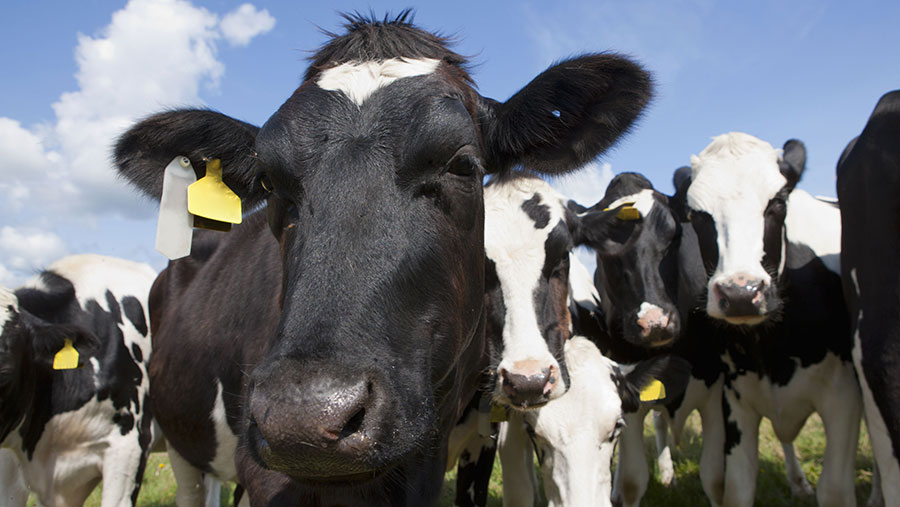BSE confirmed on farm in Aberdeenshire
 © Juice/Rex/Shutterstock
© Juice/Rex/Shutterstock A case of bovine spongiform encephalopathy (BSE) has been confirmed on a farm in Aberdeenshire.
The Scottish government said that precautionary movement restrictions have been put in place at the farm, while further investigations to identify the origin of the disease proceed.
Ministers said it was a case of classical BSE – also known as “mad cow disease” – which is commonly associated with a contaminated feed bin. But the animal did not enter the food chain, so there is no risk to human health.
See also: ‘Contaminated feed likely cause of continuing BSE cases’
It is the first case of BSE detected on a Scottish farm in more than 10 years. It was found during routine testing (carried out when an animal aged four or above dies on a farm).
‘No risk to human health’
Food Standards Scotland confirmed there was no risk to human health as a result of this isolated case.
Scottish rural economy secretary Fergus Ewing said: “Following confirmation of a case of classical BSE in Aberdeenshire, I have activated the Scottish government’s response plan to protect our valuable farming industry, including establishing a precautionary movement ban being placed on the farm.
“While it is important to stress that this is standard procedure until we have a clear understanding of the disease’s origin, this is further proof that our surveillance system for detecting this type of disease is working.
“Be assured that the Scottish government and its partners stand ready to respond to any further confirmed cases of the disease in Scotland.”
Scottish chief veterinary officer Sheila Voas said: “While it is too early to tell where the disease came from in this case, its detection is proof that our surveillance system is doing its job.
“We are working closely with the Animal and Plant Health Agency to answer this question. In the meantime, I would urge any farmer who has concerns to immediately seek veterinary advice.”
BSE trading status change
In May 2017, the World Organisation for Animal Health (OIE) recognised the BSE risk from beef raised in Scotland and Northern Ireland as “negligible” – the safest level available. This followed an application by the Scottish government to OIE for Scotland to achieve negligible risk BSE status.
NFU Scotland said the latest case would see Scotland’s international trading status in relation to BSE return to controlled risk (CR), the same ranking as already applies in England and Wales.
NFUS president Andrew McCornick said it was disappointing news for the Scottish beef industry.
But he added: “When Scotland applied for BSE negligible risk status it was with the full knowledge that there was every possibility of a sporadic case of BSE emerging as has been the case in France and Ireland.”
60 cases since 2001
BSE can be divided into classical BSE and atypical BSE. At present only the infectious agent causing classical BSE has been demonstrated to be transmissible to humans.
Classical BSE was first diagnosed in the UK in 1986. It was first a European and later a global problem affecting cattle. Epidemiological studies suggest that the source of this disease was cattle feed prepared from BSE-infected animal tissues, such as brain and spinal cord.
The common symptoms of classical BSE in cattle include behavioural changes, lack of co-ordination, difficulty in walking or standing up, decreased milk production and weight loss. However, the disease has also been detected in animals showing no symptoms.
Sixty cases of classical BSE have been reported in cattle born after an EU-wide ban on meat and bonemeal in feed was enforced in 2001. None of these animals entered the food chain.
BSE – the facts
BSE was first diagnosed in the UK in 1986, with affected cattle losing physical control, then dying.
Between 1986 and 1998 there were more than 180,000 cases diagnosed.
A further 4.4m British cattle were culled as part of the eradication policy.
The most likely cause was BSE existing in feed containing meat and bonemeal, with the agent surviving at very high rendering temperatures.
The link with new variant CJD in humans was confirmed in March 1996.
Since then, there have been more than 200 human cases, mostly in the UK.
The most likely cause was contaminated brain and spinal cord ending up in processed beef.
This led to the ban on all specific risk material in the food chain.
British beef exports were banned for 10 years – with France the last EU country to lift the ban, in May 2006.
Only cattle aged under 24 months were initially allowed to be exported.
An EU-wide ban on meat and bonemeal in feed was introduced in 2001.
Since then, the number of BSE cases has dropped from 554 in 2005 to just two in 2015.
